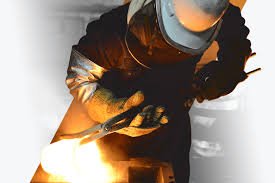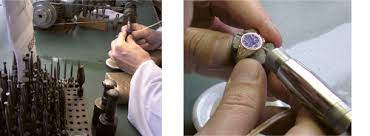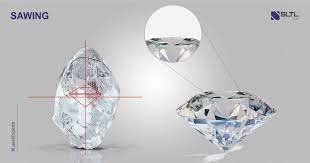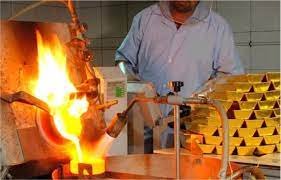Melter and Refiner
SECTOR: GEMS & JEWELLERY
SUB-SECTOR: Handmade gold and gems-set jewellery
OCCUPATION: Metal Alloying
REFERENCE ID: G&J/Q0401
ALIGNED TO: NCO-2004/7313.18
Order processor: Also called ‘Alloy maker’, the Melter and Refiner
recovers gold after melting and refining scrap gold ornaments or those
received from jewellery manufacturing and converts gold into alloys.
Brief Job Description: The individual recovers gold from jewellery pieces,
gold scrap, and dust collected at different stages of jewellery
manufacturing, by operating melting furnace and chemical processes to
recover gold in the pure form and converts into an alloy.
Personal Attributes: The job requires the individual to have: attention to
details; ability to multitask in a process driven team; ability to work in a
high temperature environment for long hours; and safely handling
hazardous chemicals. The individual is expected to have integrity in
dealing with precious metal.
Unit Code G&J/N0401
Unit Title
(Task) Melt, recover and refine gold from jewellery, scrap and gold dust and make alloy
Description This OS unit is about recovering gold from jewellery pieces, scrap and dust and
melting into pure gold or alloy
Scope This unit/task covers the following:
Collect material and consumables from stores and other departments
collect old and discarded jewellery pieces from marketing
collect scrap and dust from different stages of jewellery manufacturing
weigh the amount of material collected
Identify the type of refining process to be used
read analysis reports to determine the gold content in refinable material
assess the metals to be removed and purity of gold to be achieved after refining
assess if a clean-up is adequate for reuse or full refining is needed for pure gold
determine the extent to which a refining process is capable of achieving pure gold
determine if a grain refiner is required, the metal to be used for it and quantity
Separate base metals from precious metals using Cupellation process
add Lead to unrefined gold in porous bone-ash crucibles or cupels for small-scale
refining
heat in air to melt the metals and dissolve in Lead
allow base metal oxides to be absorbed in the cupels leaving behind metallic
beads of precious metals such as Gold, Silver and Platinum
send the precious metal alloy for further separation of Gold and other metals
for large-scale Cupellation, smelt with flux of precious metal, iron-sulphide and
lead oxide to form Lead bullion, slag and Matte of Copper
allow base metal oxides to be absorbed in the cupels leaving behind metallic
beads of precious metals such as Gold, Silver and Platinum
send the precious metal alloy for further separation of Gold and other metals
Remove base metals and silver using Iquartation and Parting method for large scale
refining
melt non-Platinum Group Metals (PGM)-gold with silver or copper to reduce the
gold content to less than 25 percent
granulate the melt and treat with Nitric acid
filter to remove the pure Gold left behind after silver and other base metals are
dissolved in Nitric acid
Use Miller process to remove base metals and silver for large scale refining
add gold scrap to crucible for melting
pass bubble chlorine gas through molten metal
take extra care in handling chlorine gas
bail out gradually forming chloride slag of base metals and silver
stop the process when purple fumes emanate
send for further electrolytic refining if purity content needed is higher than 99.5
per cent and to remove PGMs
treat slag with sodium carbonate to recover any Gold trapped in Silver
Remove PGMs using Wohlwill Electrolytic process for large scale refining
use refined gold obtained from Miller process and cast into anodes
electrolyse in gold chloride and hydrochloric acid
wash, dry, melt and granulate pure gold of 99.99 per cent deposited on the
cathode
treat spent electrolyte to recover Platinum and Palladium
filter anode slimes formed at bottom of cell and treat to recover gold
Recover and refine gold using Aqua Regia Process
melt dust at specific temperature for time period as per operating standards
granulate (make fine powder of the dust) and screen the metal
remove ferrous metal by using magnetic plate
prepare Aqua Regia solution (of hydrochloric acid and nitric acid) as per proportion
required
boil granules in Aqua Regia solution as specified to dissolve the molten gold
add urea to remove nitric acid fumes
pass solution through filter and collect molten gold at the bottom of filtration unit
add ferrous sulphate in the beaker containing gold
leave the solution until it changes colour from green to black, the bottom of the
solution containing heavy metal including gold
decant top solution containing dust and other light metals
boil heavy metal in hydrochloric acid to clean the impurities and blackness on gold
wash metal in plain water until the solution neutralises
dry recovered gold on hot plate
melt again in furnace crucible and pour in metal mould to form 24K gold rod/ bar
for diamond studded jewellery, after dissolving metal into Aqua Regia solution,
collect the diamond at the bottom of container
Remove base metals except Copper using Pyro-metallurgical process
smelt scrap gold under a flux
pass bubble air or oxygen through molten metal
remove slag containing combined impurities
send recovered gold alloy for analysis of copper or any remaining base metal
content
Melt and form pure gold or alloy
melt recovered gold in furnace crucible and pour in metal mould to form 24K gold
bar or rod
weigh metals in proportion or alloying
pickle all metals and clean thoroughly
mix all metals, except gold, in a crucible fluxed with Borax
melt the metals with a reducing flame starting with highest melting point, do not
bring the metal to boil
stir constantly with carbon stirring rod
add fine gold to the molten metal
pour molten gold alloy into gold ingot or depression in a charcoal block
check for brittleness of alloy or colour streaks, both indicating improper alloying
re-melt and remix with carbon stirring rod for accurate alloying
Maintain refining and melting unit and record
clean the unit regularly
schedule annual maintenance
maintain records of refining and alloying
record gold dust, scrap an jewellery collected and materials returned
record any damage to gemstones
record recovery percentage and weight of pure gold bar or alloy
Report problems related to:
furnace malfunction
repeated re-melting and remixing if necessary
any damage because of chemicals involved
Element Performance Criteria
Recovering, refining
and alloying of gold
To be competent, the user/individual on the job must be able to:
PC1. accurately compute proportions of mix of different solutions required for the
amount of dust and scrap collected
PC2. apply operating parameters required for different alloys
PC3. make optimum recovery of gold and precious metals
PC4. ensure no brittleness or colour streaks in alloyed metal or gold
PC5. achieve zero impurities or ash on gold
PC6. achieve zero accidents while handling chemicals and molten metal
Productivity To be competent, the user/individual on the job must be able to:
PC7. Plan well for optimum use of refining plant
PC8. achieve total quantity of scrap and dust processed against target
PC9. maximise percentage of gold recovered
Quality of output To be competent, the user/individual on the job must be able to:
PC10. achieve purity of the recovered gold as per industry specified standards
PC11. achieve minimal cracking, porosity and contamination
PC12. achieve QC-okayed metal and no defects while remaking jewellery later
A. Organizational
Context
(Knowledge of the
company /
organization and
its processes)
The individual on the job needs to know and understand:
KA1. company’s policies on: Acceptable limits of gold loss per product type;
incentives; delivery standards; safety and hazards; integrity; and personnel
management
KA2. work flow involved in company’s jewellery manufacturing process
KA3. importance of the individual’s role in the workflow
KA4. reporting structure
B. Technical
Knowledge
The user/individual on the job needs to know and understand:
KB1. assaying process
KB2. properties of pure gold and alloys such as malleability, ductility, bleaching
KB3. impurities present in gold jewelry, dust and scrap and the method for
separating them from gold
KB4. gold karatages and proportion of mixing other metals such as silver, copper,
zinc, palladium in order to form alloy
KB5. how to lower or increase karatage of alloy
KB6. uses of different refining processes for different purposes and end results
KB7. refining process planning
KB8. sources of error in achieving desired purity of refined gold
KB9. melting point of different alloying metals
KB10. annealing for ductility and temperature effect on alloyed metals
KB11. types of precious metals and gemstones used
KB12. different types of jewellery and their making technique, e.g., casting or
handmade
KB13. different types of components used in jewellery and their making techniques
KB14. level of acid resistance of different types of gemstones
Skills (S) [Optional]
A. Core Skills/
Generic Skills
Reading and typing skills
The user/individual on the job needs to know and understand how:
SA1. to read assay reports
SA2. to read design notes and operating procedure for refining and melting unit
SA3. to read company rules and compliance documents required to complete the
work
Calculation skills
The user/individual on the job needs to know and understand:
SA4. to calculate alloying mix and solution mix proportions
SA5. to weigh dust an scrap in order to mix alloying metal for optimum results
Teamwork and multitasking
The user/individual on the job needs to know and understand how:
SA6. to deliver refined and alloyed gold to stores in time
SA7. to share knowledge with co-workers
B. Professional Skills Refining unit management
The user/individual on the job needs to know and understand how:
SB1. how to operate the refining, melting and alloying unit
SB2. handle the different stages of refining process
SB3. adhere to time schedule for melting/ smelting process
SB4. handle recovered gold and other base metals and PGMs
SB5. record outcomes of refining, melting and alloying as per company rules
Using tools and machines
The user/individual on the job needs to know and understand how:
SB6. to use appropriate tools for holding the crucible or stirring such as different
types of holders or carbon stirring rod
SB7. to operate the furnace at appropriate temperatures by reducing heat for
meting alloying metals or melting gold
SB8. to use chemicals such as ferrous sulphate, hydrochloric acid, nitric acid, and
borax without any hazards
Reducing precious metal loss
The user/individual on the job needs to know and understand:
SB9. how to reduce precious metal loss below the prescribed standards
SB10. how to collect broken pieces, account in job sheet and return
SB11. how to follow company’s policies on collecting gold dust and fragments
SB12. how to suggest improvements in order to reduce precious metal loss limits
Reflective thinking
The user/individual on the job needs to know and understand how:
SB13. to improve work process
SB14. to improve recovery percentage and purity of gold
Critical thinking
The user/individual on the job needs to know and understand how:
SB15. to anticipate process disruptions and reasons for delay
G&J/N9910 Maintain IPR and respect copyright
Unit Code G&J/N9910
Unit Title
(Task) Respect IPR of company as well as competitors
Description This OS unit is about maintaining company’s IPR and avoiding infringement on
copyright of others
Scope This unit/task covers the following:
Protect company’s Intellectual Property Rights (IPR)
prevent leak of new designs to competitors by reporting on time
be aware of any of company’s product or design patents
report IPR violations observed in the market, to supervisor or company heads
Avoid infringement to copyright of other companies
read copyright clause of the material published on the internet and any other
printed material
consult supervisor or senior management when in doubt about using publicly
available information
report any infringement observed in the company
Performance Criteria(PC) w.r.t. the Scope
Element Performance Criteria
Respecting IPR To be competent, the user/individual on the job must be able to:
PC1. spot plagiarism and report
PC2. understand rationale of patents and IPR
PC3. avoid being involved in IPR violations
Knowledge and Understanding (K)
A. Organizational
Context
The individual on the job needs to know and understand:
KA1. company’s policies on IPR, plagiarism and order leaks
KA2. company’s patented products
KA3. market trends and company’s unique product range
KA4. reporting structure
B. Technical
Knowledge
The individual on the job needs to know and understand:
KB1. basics of patents and IPR laws
KB2. how IPR protection is important for competitiveness of a company
Skills (S) [Optional]
A. Core Skills/
Generic Skills
Communication skills
The user/individual on the job needs to know and understand how:
SA1. to effectively communicate any observed IPR violations or design leaks
B. Professional Skills Decision making
The user/individual on the job needs to know and understand when and how:
SB1. to report sources of IPR violations
Reflective thinking
The user/individual on the job needs to know and understand how:
SB2. to learn from past mistakes and report IPR violations on time
Critical thinking
The user/individual on the job needs to know and understand how:
SB3. to spot signs of violations and alert authorities in time
Unit Code G&J/N9912
Unit Title
(Task) Coordinate with co-workers
Description This OS unit is about communicating with colleagues and seniors in order to maintain
smooth ad hazards free work flow
Scope This unit/task covers the following:
Interact with supervisor to:
receive work instructions and raw materials from reporting supervisor
communicate to reporting supervisor about process flow improvements, product
defects received from previous process, repairs and maintenance of tools and
machinery as required
communicate any potential hazards or expected process disruptions
handover completed work to supervisor
Interact with colleagues within and outside the department to:
work as a team with colleagues and share work as per their or own work load and
skills
work with colleagues of other departments such as frame making or component
making or polishing or setting or stores
communicate an discuss work flow related difficulties in order to find solutions
with mutual agreement
receive feedback from QC and rework in order to complete work on time
Performance Criteria(PC) w.r.t. the Scope
Element Performance Criteria
Interaction with
supervisor
To be competent, the user/individual on the job must be able to:
PC1. understand the work output requirements
PC2. comply with company policy and rule
PC3. deliver quality work on time as required by reporting any anticipated reasons
for delays
Interactions with
colleagues and other
departments
To be competent, the user/individual on the job must be able to:
PC4. put team over individual goals
PC5. conflicts resolution and multi-tasking
Knowledge and Understanding (K)
A. Organizational
Context
(Knowledge of the
company /
organization and
its processes)
The individual on the job needs to know and understand:
KA1. company’s policies on personnel management
KA2. work flow involved in company’s jewellery manufacturing process
KA3. importance of the individual’s role in the workflow
KA4. reporting structure
B. Technical
Knowledge
The individual on the job needs to know and understand:
KB1. how to communicate effectively
KB2. how to build team coordination
Skills (S) [Optional]
A. Core Skills/
Generic Skills
Teamwork and some multitasking
The individual on the job needs to know and understand how:
SA1. to share work load as required
SA2. to deliver product to next work process on time
B. Professional Skills Decision making
The individual on the job needs to know and understand:
SB1. how to report potential areas of disruptions to work process
SB2. when to report to supervisor and when to deal with a colleague depending on
the type of concern
Reflective thinking
The individual on the job needs to know and understand:
SB3. how to improve work process
Critical thinking
The individual on the job needs to know and understand:
SB4. how to spot process disruptions and delays
Unit Code G&J/N9914
Unit Title
(Task) Work towards having a safe work environment
Description This OS unit is about being aware of and communicating potential hazards and
dangers of accidents on the job
Scope This unit/task covers the following:
Understand potential sources of accidents
to avoid accidents related to use of potentially dangerous chemicals, gas torches,
sharp tools and hazards from machines
Communicate to reporting supervisor about:
process flow improvements to reduce anticipated or repetitive hazards
mishandling of tools, machines or hazardous materials
electrical problems that could result in accident
Performance Criteria(PC) w.r.t. the Scope
Element Performance Criteria
Understanding of
potential sources of
accidents and
communicating
To be competent, the user/individual on the job must be able to:
PC1. spot and report potential hazards on time
PC2. follow company policy and rules regarding hazardous materials
PC3. deliver quality work on time as required by reporting any anticipated reasons
for delays
Knowledge and Understanding (K)
A. Organizational
Context
(Knowledge of the
company /
organization and
its processes)
The individual on the job needs to know and understand:
KA1. company’s policies on handling: harmful chemicals and sharp tools, safety and
hazards of machines, fire safety and, disposal of harmful chemicals and
materials
KA2. work flow involved in company’s jewellery manufacturing process
KA3. importance of the individual’s role in the workflow
KA4. reporting structure
B. Technical
Knowledge
The individual on the job needs to know and understand:
KB1. how different chemicals react and what could be the danger from them
KB2. how to use machines and tools without causing bodily harm
KB3. fire safety education
KB4. disposal of hazardous chemicals, tools and materials by following prescribed
environmental norms or as per company policy
Skills (S) [Optional]
A. Core Skills/
Generic Skills
Communication skills
The individual on the job needs to know and understand how:
SA1. to effectively communicate the danger
B. Professional Skills Decision making
The individual on the job needs to know and understand:
SB1. importance of reporting potential sources of danger
SB2. appropriate actions to be taken in the event of an accident
SB3. procedure for disposing of hazardous materials, safely and following
environmental guidelines
Reflective thinking
The individual on the job needs to know and understand how:
SB4. to learn from past mistakes regarding use of hazardous machines or
chemicals or gas torches
Critical thinking
The individual on the job needs to know and understand:
SB5. how to spot danger
SB6. procedure to follow in the event of a fire or other hazard
Keywords /Terms Description
Sector Sector is a conglomeration of different business operations having similar
business and interests. It may also be defined as a distinct subset of the
economy whose components share similar characteristics and interests.
Sub-sector Sub-sector is derived from a further breakdown based on the
characteristics and interests of its components.
Occupation Occupation is a set of job roles, which perform similar/ related set of
functions in an industry.
Function Function is an activity necessary for achieving the key purpose of the
sector, occupation, or an area of work, which can be carried out by a
person or a group of persons. Functions are identified through functional
analysis and form the basis of OS.
Sub-function Sub-functions are sub-activities essential to fulfil the achieving the
objectives of the function.
Job role Job role defines a unique set of functions that together form a unique
employment opportunity in an organisation.
Occupational Standards
(OS)
OS specify the standards of performance an individual must achieve
when carrying out a function in the workplace, together with the
knowledge and understanding they need to meet that standard
consistently. Occupational Standards are applicable both in the Indian
and global contexts.
Performance Criteria Performance criteria are statements that together specify the standard of
performance required when carrying out a task.
National Occupational
Standards (OS)
NOS are occupational standards which apply uniquely in the Indian
context.
Qualifications Pack (QP) QP comprises the set of OS, together with the educational, training and
other criteria required to perform a job role. A QP is assigned a unique
qualifications pack code.
Unit Code Unit code is a unique identifier for an Occupational Standard, which is
denoted by an ‘N’
Unit Title Unit title gives a clear overall statement about what the incumbent
should be able to do.
Description Description gives a short summary of the unit content. This would be
helpful to anyone searching on a database to verify that this is the
appropriate OS they are looking for.
Scope Scope is a set of statements specifying the range of variables that an
individual may have to deal with in carrying out the function which have
a critical impact on quality of performance required.
Knowledge and
Understanding
Knowledge and understanding are statements which together specify the
technical, generic, professional and organisational specific knowledge
that an individual needs in order to perform to the required standard.
Organisational Context Organisational context includes the way the organisation is structured
and how it operates, including the extent of operative knowledge
managers have of their relevant areas of responsibility.
Technical Knowledge Technical knowledge is the specific knowledge needed to accomplish
specific designated responsibilities.
Core Skills/ Generic
Skills
Core skills or generic skills are a group of skills that are the key to learning
and working in today’s world. These skills are typically needed in any
work environment in today’s world. These skills are typically needed in
any work environment. In the context of the OS, these include
communication related skills that are applicable to most job roles.
Keywords /Terms Description
IPR Intellectual Property Rights
NOS National Occupational Standard(s)
NVQF National Vocational Qualifications Framework
NSQF National Qualifications Framework
NVEQF National Vocational Education Qualifications Framework
QP Qualifications Pack
PGM Platinum Group Metals
CRITERIA FOR ASSESSMENT OF TRAINEES
Job Role Melter and Refiner
Qualification Pack Melter and Refiner
Sector Skill Council
GEMS & JEWELLERY
Guidelines for Assessment:
- To pass the Qualification Pack , every trainee should score a minimum of 50% in theory and 70% in practical assessments.
Marks Allocation
Theory Skills Practical
G&J/N0401 This OS unit
is about recovering gold
from jewellery pieces,
scrap and dust and
melting into pure gold or
alloy
PC1. accurately compute proportions of mix of different solutions required for the amount of
dust and scrap collected 1 8
PC2. apply operating parameters required for different alloys 1 8
PC3. make optimum recovery of gold and precious metals 0 8
PC4. ensure no brittleness or colour streaks in alloyed metal or gold 1 6
PC5. achieve zero impurities or ash on gold 0 4
PC6. achieve zero accidents while handling chemicals and molten metal 1 4
PC7. Plan well for optimum use of refining plant 0 6
PC8. achieve total quantity of scrap and dust processed against target 1 7
PC9. maximise percentage of gold recovered 1 7
PC10. achieve purity of the recovered gold as per industry specified standards 1 6
PC11. achieve minimal cracking, porosity and contamination 0 5
PC12. achieve QC-okayed metal and no defects while remaking jewellery later 0 6
7 75
G&J/N9910 This OS unit
is about maintaining
company’s IPR and
avoiding infringement on
copyright of others
PC1. spot plagiarism and report 1 0
PC2. understand rationale of patents and IPR 1 0
PC3. avoid being involved in IPR violations 1 0
3 0
G&J/N9912 This OS unit
is about communicating
with colleagues and
seniors in order to
maintain smooth ad
hazards free work flow
PC1. understand the work output requirements 2 0
PC2. comply with company policy and rule 2 0
PC3. deliver quality work on time as required by reporting any anticipated reasons for delays 0 3
4 3
G&J/N9914 This OS unit
is about being aware of
and communicating
potential hazards and
dangers of accidents on
the job
PC1. spot and report potential hazards on time
2 0
PC2. follow company policy and rules regarding hazardous materials 2 0
PC3. deliver quality work on time as required by reporting any anticipated reasons for delays 2 2
6 2
20 80








